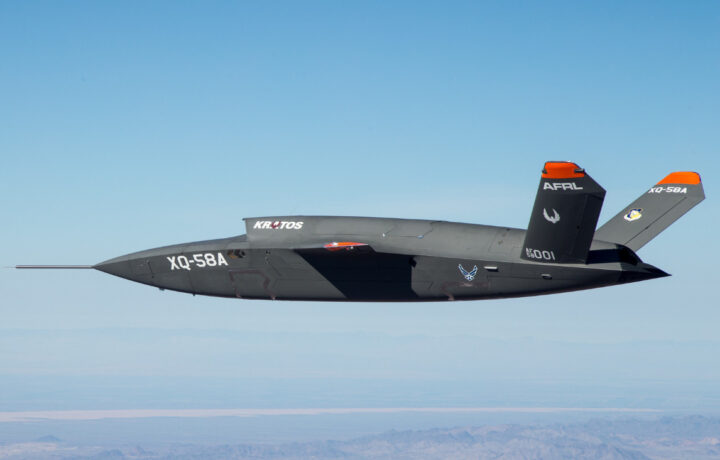Dogs may be man’s best friend, but the United States Air Force is now seeking to spend nearly $6 billion to build an artificial intelligence (AI) driven collaborative combat aircraft. The autonomous aircraft could be the pilot-of-the-future’s best friend – able to protect its human aviator and even complete suicide missions if needed.
It will be powered by a rocket engine and fly distances as great, and perhaps even greater, than any manned aircraft and will be both stealthy enough to avoid detection while able to carry out missions that can strike an enemy well beyond visual range.
Unmanned aerial vehicles powered by AI, such as the XQ-58A Valkyrie, are being poised to be the ultimate “loyal wingman.”
Test Flights Already Underway
Such aircraft could be a component of the U.S. Air Force’s Next Generation Air Dominance (NGAD) program, which is more than a single aircraft. It is actually a system of systems that will include an “optionally manned” sixth-generation multirole fighter – which will replace the Lockheed Martin F-22 Raptor – along with unmanned Collaborative Combat Aircraft (CCA) also previously known as Loyal Wingmen.
Last month, the service announced that it had conducted a successful flight on July 25 of the XQ-58A Valkyrie, which is equipped with AI and machine learning (ML) capabilities. The three-hour test flight, conducted and monitored by the Air Force Research Laboratory (AFRL) at the Eglin Test and Training Complex, was directed by AI/ML systems developed at the lab. The aircraft successfully demonstrated the ability to process information needed to complete its mission.
“The mission proved out a multi-layer safety framework on an AI/ML-flown uncrewed aircraft and demonstrated an AI/ML agent solving a tactically relevant ‘challenge problem’ during airborne operations,” said Col. Tucker Hamilton, DAF AI Test and Operations chief, via a statement. “This sortie officially enables the ability to develop AI/ML agents that will execute modern air-to-air and air-to-surface skills that are immediately transferrable to other autonomy programs.”
The $6 Billion Loyal Wingman
The United States Department (DoD) has remained committed to the responsible development and employment of AI, even as some critics of the technology have warned that it could pose dangers to friend and foe alike. The U.S. military has sought to ensure that the technology will be used according to the accepted rules of engagement and that it could be employed to keep U.S. service members – including pilots – out of harm’s way.
“AI will be a critical element to future warfighting and the speed at which we’re going to have to understand the operational picture and make decisions,” said Brig. Gen. Scott Cain, AFRL commander. “AI, Autonomous Operations, and Human-Machine Teaming continue to evolve at an unprecedented pace and we need the coordinated efforts of our government, academia and industry partners to keep pace.”
Though Congress has yet to approve the budgetary estimate, the service has sought around $5.8 billion in planned expenses to develop the CCA over the next five years. Unlike with current aircraft that are delivered as a package, the Air Force may seek to split up the aircraft and software as separate purchases.
Filling the Ranks
The XQ-58A Valkyrie, which can reportedly reach speeds of up to 550 mph, is just one potential contender for the NGAD program, and later this year, it will be tested in a simulation to chase and destroy a target over the Gulf of Mexico.
A loyal wingman is especially attractive to the U.S. Air Force as the service has in recent decades built fewer and fewer, yet increasingly expensive aircraft such as the Lockheed Martin F-35 Lightning II, which costs $80 million per unit. That has left the service with a significantly smaller fleet – not to mention many older aircraft, like the B-52 bombers that are older than the parents (and in many cases the grandparents) of the current generation of aircrews.
The Air Force has plans to build 1,000 to 2,000 of the CCA, for as little as $3 million apiece while more advanced variants could be $25 million, according to a recent report from The New York Times. Even at the high end that is just a fraction of the cost of today’s advanced aircraft like the F-35. Some in the Air Force have already described the program as “affordable mass.”
The CCA likely won’t be multirole aircraft like the F-35 however, and instead could be more specialized to particular roles. That could include surveillance while others could be geared towards resupply missions. Some could fly in attack swarms to overwhelm an enemy, while there will also be those true “loyal wingmen” that protect a manned aircraft – and which are willing and able to take a bullet or more likely an anti-aircraft missile for their human.
They could fly in front of piloted combat aircraft, take part in high-risk surveillance, and then disable enemy air defenses. That could help ensure the more valuable fighter and pilot can make it home again.
Rise of the Machines?
There are still critics who worry that the military could risk losing control of the devices.
“You’re stepping over a moral line by outsourcing killing to machines — by allowing computer sensors rather than humans to take human life,” Mary Wareham, the advocacy director of the arms division of Human Rights Watch, which is pushing for international limits on so-called lethally autonomous weapons, also told The New York Times.
The Air Force has also acknowledged that AI doesn’t truly think like a human, but it maintains that the goal is to help its pilots get the job done. The goal of the CCA effort is to help ensure that the aviators can accomplish the mission and make it back home alive.




